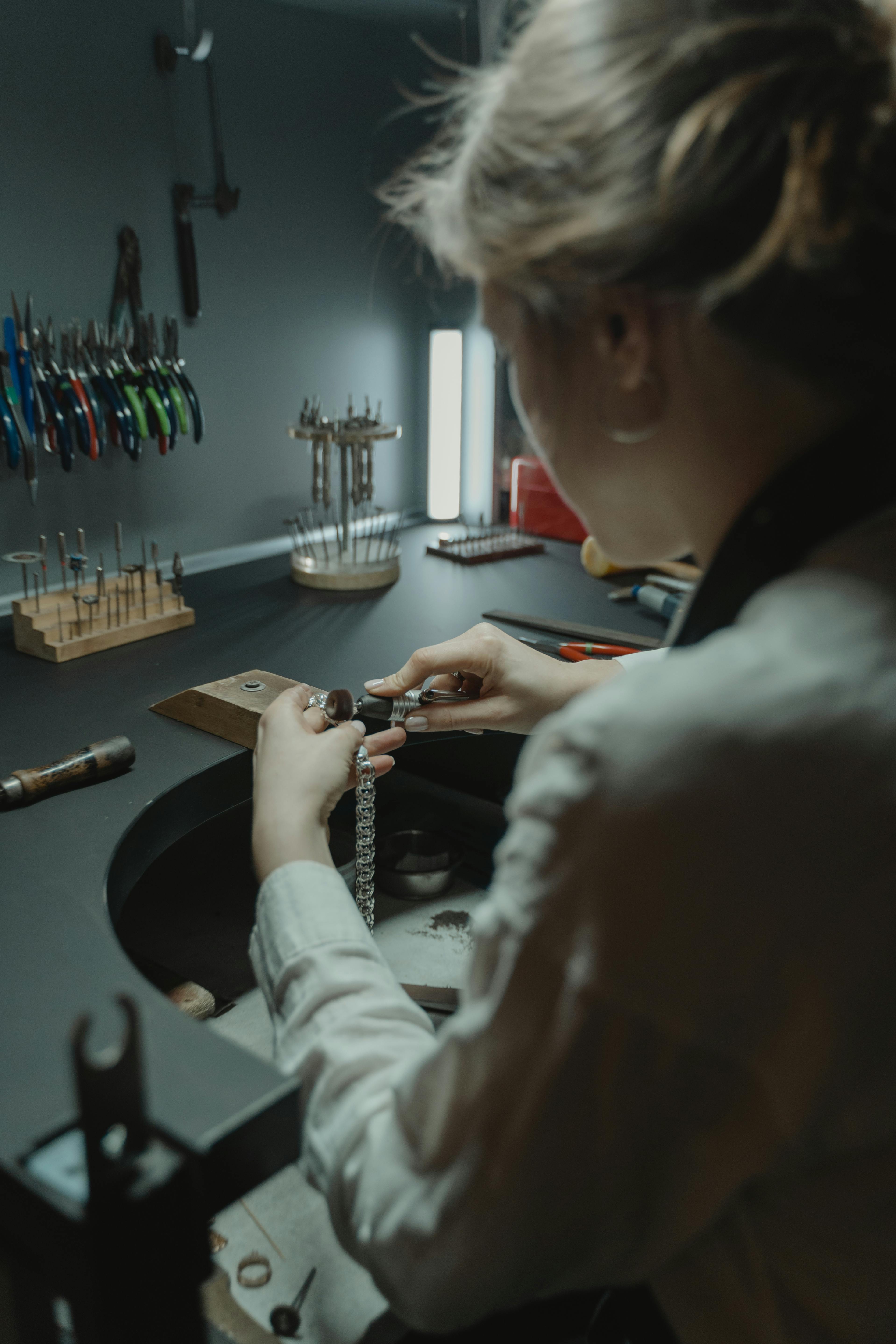
Freshwater pearls look elegant, yet their lustre can fade and their string weaken from everyday contact with skin oils, cosmetics and moisture. If you own a necklace, it is easy to worry that cleaning or wearing it might do more harm than good.
This guide shows how to recognise pearls' specific vulnerabilities, protect them during daily wear, clean them without harsh chemicals, store and care for knots and string, and arrange professional maintenance when needed. Follow these practical steps to preserve your pearls' lustre and avoid the common mistakes that shorten a necklace's life.
Recognise freshwater pearl vulnerabilities
Freshwater pearls build their lustre from many thin layers of aragonite crystals bonded with organic conchiolin, which produces the iridescent surface but leaves them comparatively soft and prone to scratches, chips, and surface wear. Chemical exposure to acids, perfumes, cosmetics, hair products, chlorine, and saltwater can etch or discolour the nacre and weaken natural silk, so put pearls on after applying products and remove them before swimming or using cleaning chemicals. Wipe pearls gently with a soft, slightly damp, lint-free cloth after wearing to lift oils and residues without abrading the surface. Avoid hard knocks and abrasive contact to preserve the layered nacre.
Abrasion from metal clasps, other jewellery, and rough fabrics will dull the surface over time, so store pearls separately in a soft pouch and lay necklaces flat to prevent tangles and rubbing. Natural silk or fibre thread can stretch, fray, or rot from moisture, sweat, and oils, producing uneven spacing or breakage; check knots and clasps before wearing and restring when the thread shows visible fraying, stretching, or slack. Avoid prolonged direct sunlight, high heat, and steam which can dry and fade the nacre, and skip ultrasonic or steam cleaners in favour of gentle, professional cleaning for deep maintenance.
Try a delicate freshwater pearl bracelet; wipe gently after wearing.

Protect pearls during daily wear
Put a pearl necklace on last, after moisturiser, perfume, and hair products, and remove it first before washing or exercising, because natural skin oils help maintain lustre while cosmetics and alcohol-based sprays can dull the nacre. Avoid exposing pearls to acids, sweat, or household chemicals, since pearls rank low on the Mohs hardness scale and even mild abrasives or acidic residues can scratch or dull their surface and weaken the silk thread. Adopting these simple habits reduces the risk of surface damage and thread deterioration.
After wearing, wipe each pearl with a soft, lint-free cloth slightly dampened with clean water to remove salt, sweat, and residue, then lay the necklace flat to air dry completely to prevent thread stretch and mildew. Store necklaces flat and separated from other jewellery in a soft, breathable pouch or a jewellery box with a soft lining, away from direct sunlight and heat, to prevent scratches, tangling, and drying of the silk. Inspect the string, knots, and clasp regularly, and restring using knotted spacers between beads at the first sign of fraying so a single failure does not result in the loss of multiple pearls.
Choose an 18 inch pearl strand finished with gold beads.

Clean pearls safely without harsh chemicals
To clean pearls safely, mix a few drops of pH neutral soap in warm water, dampen a soft microfibre cloth, and gently wipe each pearl one by one, rinsing the cloth and repeating as needed. Lay the necklace flat on a soft towel to air dry away from direct heat, and avoid prolonged soaking of knotted strands to protect the silk. Harsh cleaners and ultrasonic or steam cleaners can erode the calcium carbonate nacre or crack layers and loosen knots, which visibly dulls lustre.
After wearing, wipe pearls with a clean, dry soft cloth to remove oils, cosmetics, and sweat that gradually dull lustre, then store the strand flat and separately in a soft pouch to prevent abrasion. For spots, blot stains with a cloth dampened in diluted pH neutral soap rather than rubbing, test on an inconspicuous pearl first, and use a soft brush only for grime on the pearl body, not on the knots. Clean metal clasps separately with a soft jewellery cloth and keep liquid cleaners off the pearls. Inspect knots and string for fraying and arrange restringing when knots loosen or the strand feels slack, since knotted construction prevents pearls rubbing and limits loss if the strand breaks.
- Quick daily routine: after wearing, wipe each pearl with a clean, dry soft cloth to remove oils, cosmetics, and sweat that gradually dull lustre; lay the strand flat on a soft towel to air dry away from direct heat, then store flat and separately in a soft pouch to prevent abrasion.
- Safe home cleaning: mix a few drops of pH neutral soap in warm water, dampen a soft microfibre cloth, and gently wipe pearls one by one, rinsing the cloth and repeating as needed; blot stains with a damp cloth rather than rubbing, use a soft brush only for surface grime, and avoid prolonged soaking of knotted strands to protect the silk.
- Avoid these actions: do not use ultrasonic or steam cleaners, harsh chemical cleaners, or keep pearls with other jewellery, as these can erode the calcium carbonate nacre, crack layers, cause abrasion, or loosen knots.
- When to seek professional care: arrange restringing or expert attention if knots are frayed or stretched, the strand feels slack, pearls sit loose, the silk shows discolouration, or the clasp is damaged; a professional can restring using knotted construction to prevent rubbing and limit loss.

Store pearls properly, tend knots and string
Store pearls flat, wrapped in a soft, breathable cloth and kept separate from other jewellery to prevent abrasion; avoid airtight plastic, which can trap moisture and accelerate thread deterioration, and keep strands away from extreme humidity or heat to prevent stretching and glue failure. Ensure there is a knot between each pearl and that knots sit close to the beads, because knots stop pearls rubbing and limit loss if the string breaks, so have a trained jeweller add or tighten knots if the strand is unknotted or the knots look loose. Inspect the thread regularly by running your fingertips along the strand and holding it up to the light to spot fraying, thinning, discolouration, or uneven spacing, and restring as soon as you notice fuzzy fibres, stretching, or loosened knots, since body oils and cosmetics progressively weaken natural silk and other threads.
When restringing, use an appropriate, flexible thread and secure end fittings so the clasp cannot cut into the last pearls; ask for close, well-formed knots and for the ends to be finished with bead tips or equivalent protection to reduce wear at the clasp. Adopt simple habits that extend string life: put pearls on after applying perfume, cosmetics, and body oils, remove them before bathing or exercising, and wipe the beads with a soft cloth after wearing to remove oils and residues that can abrade pearls and degrade the thread. These practices preserve the beads and the string, and they reduce the frequency of professional restringing by limiting the factors that cause fibre breakdown.
Choose a knotted freshwater pearl bracelet with textured gold accents
Arrange professional maintenance and restringing
Ask a professional to inspect thread integrity, the condition of drilled holes, knot security, and clasp attachment, because pearls are softer than metal and contact or friction can widen holes and fray silk fibres. Request restringing with knots between each pearl on quality silk or another suitable cord, and discuss single or double knots to prevent pearls rubbing or slipping. Ensure the technician tensions the strand so it hangs with a natural drape, avoiding strain on the drill holes. Where appropriate, seek reversible, matched findings and protective measures at high contact points to reduce future wear while preserve original material.
A professional will remove accumulated body oils and dirt from surfaces and drill holes using pH neutral solutions and soft cloths, and will avoid abrasive or ultrasonic methods that can damage the nacre. Ask for a condition report with photographs, a written description of materials and any repairs, and clear aftercare instructions so you can track changes, demonstrate provenance, and support insurance or future conservation. Choose sympathetic repairs such as replacing worn findings with reversible fittings or adding protective sleeves at high-contact points, so the necklace remains usable while retaining as much original material as possible.
Freshwater pearls retain their beauty when you protect them from chemicals, abrasion, and moisture, and when you follow simple daily habits that reduce wear. Regular gentle cleaning, careful storage, and timely restringing preserve the nacre and extend a necklace's life.
Refer to the sections above for practical steps on wearing, cleaning, storage, and professional maintenance to make these actions routine. Inspect and act at the first sign of fraying or dullness to avoid irreversible damage and keep your pearls wearable and attractive.







